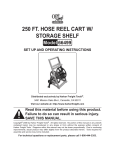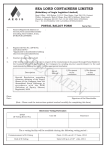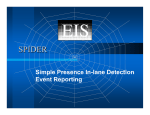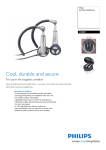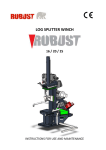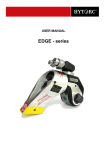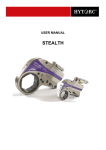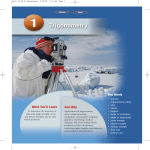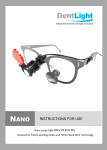Download Instructions in PDF format
Transcript
THIMBLE-DROME TD-1 AIRPLANE THIS AIRPLANE is the very finest ready-to-fly airplane that can be purchased anywhere. It is designed to fly beautifully and gracefully. The power plant is the finest made anywhere in the world and is especially engineered for very easy starting. This plane is designed to give you the utmost flying pleasure without the many weeks of tedious work involved in building your own. YOU HAVE BOUGHT A SPORT, NOT A TOY. A sport a father and son can enjoy together. Prepare yourself accordingly and do not attempt to fly this plane until you fully understand the procedure. The TD-1 also represents considerable investment which can be lost in an instance through carelessness or impatience. While this plane is tough and rugged, any plane light enough to fly well will not withstand hard crackups, whether it be a model or a real plane. Most crackups with the TD-1 can be repaired for less than $2.00 but a total washout is always a possibility, especially if it is out of control and comes straight in from overhead. Protect Your Investment, Read the Following: 1. Do not attempt to fly just anyplace. Be sure the area is large enough, smooth, and there are no overhead wires. Flying over grass is recommended for the beginner, taking off of a smooth surface at the edge. 2. Do not fly in a wind or even in a light breeze until and unless you are experienced. 3. Nylon lines are furnished with this plane and are adequate for sport flying, but do not attempt to stunt this plane or fly in a stiff breeze unless you use steel flying lines. or 4 times a day for 4 or 5 days should do the trick. Do not overdo this at first or you might become ill. 7. Do not attempt to fly this plane without an instructor, who should have his hands on yours to take over should you lose control. You will find flying on public flying circles with other flyers most interesting and helpful. If you are not too proud to ask, any good flyer will help and instruct you. You will find him flattered at being asked and more than eager to help. Go to your local hobby shop for information on flying fields, clubs, and instruction. 4. While learning to fly use the holes in the control handle that give not more than 2 ½ “ line spread; 1 ½” is even better. More spread makes control too sensitive for the beginner. Each and every time you fly, be sure to test the controls the last instant before releasing plane to see that they respond correctly. 8. Do not attempt to fly this plane until you fully understand how to operate the Space Bug engine. (Read engine manual carefully) 5. Do not run the engine for long intervals when not flying unless you remove the engine cowling. Stationary running generates enough heat inside the cowling to soften the plastic and warp it out of shape. This plane is easily assembled or dis-assembled. If adjustment or service is required from the factory do not under any circumstances return the entire plane. return only the part in question. For engine repair or service remove the engine and send it alone. Packaging the plane for safe transportation is expensive and difficult. Should the entire plane be sent to the factory without sufficient cause it will not be returned until or unless packaging and postage are paid for. 6. Prepare yourself in advance so you will not get dizzy while at the control. Practice turning around to the left about 1 turn every 3 seconds until you can make 25 or 30 turns without excessive dizziness. Trying this 3 IMPORTANT ASSEMBLY INSTRUCTIONS Your knockdown TD-1 airplane is partially assembled at the factory. A small screwdriver is the only tool necessary to complete the assembly. By carefully following the simple instructions outlined below no difficulty will be encountered in completing the assembly. 1. WING bulkhead behind the wing. Secure the body bottom in place with the three self tapping screws J, provided. The short screw goes in the rear hole and the long screw goes in the front hole. Do not over-tighten these screws. They form threads in the plastic as they are driven and over-tightening may strip the plastic threads. 3. CONTROL CHECK Never squeeze the wing or lift the plane by taking hold of the wing’s flying surfaces. Always handle the wing by the edges. The control mechanism is already inside the wing but is not in place because of packaging limitations. Figure 1 shows the proper position of the mechanism as seen when looking through the holes in the bottom of the wing. Be sure the lead out wires C are not twisted or crossed. Make certain control wire D is positioned exactly as shown. The bell crank hole nearest If the assembly instructions have been followed carefully the elevator controls will work freely and smoothly. Pulling the rear wing wire should move the elevator upwards. Pulling the forward wing wire will move the elevator down. the pivot pin should be used unless you are already an expert flyer and like a sensitive control. Place one end of the pivot pin A in the hole in the wing at E. Raise the pin to the standing position. This will bulge out the wing until the other end of the pin snaps into the other hole B. The wing will not spread enough to let the pin come out after the fuselage is assembled on the wing. Skylon control reel, load it as follows: 2. FINAL ASSEMBLY Support the upper half of the body upside down, Figure 2. Set the wing in position, being careful that the body guide ribs F on the wing are both inside the body. Slip the bent end of the control wire D through the small hole in the elevator horn G. Hold the landing gear assembly H in place and then set the bottom half of the body in place. When positioning the bottom half be careful that the control wire D slips into the notch I in the REEL LOADING AND ASSEMBLY If your plane came equipped with the Thimble-Drome 1. First lift Spring A, figure 3, and slide it out. This lets pins B come out and also the two spools. Unroll the nylon line from spool D, Figure 3. There is enough line for two 35 foot control lines. Double the line back, and cut it in two. Put the end of the line through the tiny hole in the reel, knot it so it will not pull out and wind it on the spool, one line on each spool. Roll it on so the line does not become twisted. Be sure to wind the lines on in the correct direction. Replace the spool D with the notched side toward the back of the case and with the end of the line going out through hole C, Figure 3. Re-assemble the other reel, pin, and spring. Lace the lines through the holes in the case to the desired flying position and tie on the snaps as illustrated in Figure 4. 2. Knob F, Figure 3, when turned to the raised position dis-engages the reels from each other so the length of the lines can be adjusted individually for the best control position of the handle. Always turn the knob to the raised position to unreel the lines. This will prevent the lines from becoming tangled in the case. To unreel the lines raise spring A, figure 3, and move it to one side. Turn knob F to the raised position. Pull out the lines and adjust them to the same length. Lock the reels with spring A and snap knob F down. Before flying, again check the handle position with tight lines after they are attached to the plane. After flying, merely move spring A to one side and wind the lines, walking up to the plane as you do so. FLYING THE PLANE Do not try to fly this plane until you have studied your engine manual carefully, and you are familiar with the engine. 1. Pull out about 30 feet of line and adjust the lines so they are even. Hook them to the airplane control wires. The lines must be connected to the plane so that raising the arm, Figure 5, will raise the elevator, and lowering the arm will lower the elevator. 2. Start the engine, let it run about 10 seconds then lean it down to maximum r.p.m. 3. The plane is held on the ground and released on signal from the pilot who is in the center of the circle with the control handle in the level position so the elevator is straight with the horizontal stabilizer. Never throw the plane to launch it. Let it take off with a rolling start. 4. As soon as the plane has run a few feet after release, the pilot will slowly raise his forearm and the plane will take to the air. Many beginners on their first attempt to fly, get “buck fever” and fail to use down control to level off after the plane leaves the ground. This results in a flight which goes right overhead then a power dive to the ground. Result: a demolished plane. Do not fly until you know you can overcome this tendency. Raise the arm to make it climb. Lower the arm to make it descend. The beginner should control from the elbow, Figure 5. 5. If you are an inexperienced pilot it is best to let the engine run a while to use up most of the fuel before releasing the plane, so it will make a short flight, just in case you get dizzy. Some pilot do get dizzy the first few flights. TIPS AND GENERAL INFORMATION 1. The engine in the TD-1 is a hopped-up version of the Space Bug and requires a different needle valve position for starting than what the engine manual calls for. Open the needle valve 5 or 6 turns for starting. 2. The hole in the bottom of the engine cowl is the overflow hole. To keep the plane cleaner a short piece of the rubber tubing, about 1 ½ inch long may be inserted over the overflow tube and be left sticking out. 3. Engine Cowling: The engine cowling may be removed by taking out the two screws on the underside of the cowling. The plane may be flown without the cowling if desired but additional weight should be attached to the engine or front of the plane to obtain proper balance. Otherwise control will be too sensitive and a crack-up may result. Always remove cowling to run the engine any length of time without flying, otherwise heat will melt it out of shape. 4. Elevator: Always be sure the elevator works smoothly and easily. Oil the center bearing if necessary. In case a hinge pin breaks off, a hole can be bored where the pin was and a short piece of wire or nail will answer nicely for a new pin; or a hinge strap can be applied as on homemade airplanes. 5. To remove or replace wheels the hub caps will snap off if you pull on them. 6. For maximum performance always use a 6”-3” pitch propeller on this plane. For slow flying try different propellers. Thimble-Drome racing fuel will give you the very finest performance with this engine. 7. A good coat of fuel proofer will make the decals last much longer. Get this from your local hobby shop. Never wash the plastic parts in gasoline or petroleum thinners. Gasoline will discolor and fog the finish. Certain waxes will also fog the finish and the cockpit canopy. Wash plastic parts with soap and water or just wipe clean. 8. When returning parts for replacement or service never under any circumstances return the entire plane to the factory. Remove the part you wish to return. 9. Due to the fragile nature of all airplanes that are built to fly well, the TD-1 cannot be guaranteed against crackups. Since something has to go when the plane cracks up hard, the fuselage has purposely been designed so it will break before the stresses build up to the point where the wing would be damaged. Thus the wing will almost always be released before it suffers any damage. This was done because the fuselage can be replaced at less cost than the wing. 10. Stunt flying: If you wish to do stunt flying it is recommended that you use flying lines of wire or cable instead of the nylon lines furnished with the plane. Nylon is only for sport flying. Do not try to wind metal lines on your Skylon reel. Do not try to stunt the plane after it has run long enough to be low on fuel. Should the engine finish its run in a steep climb or inverted, a crash landing will be in order. It may e less expensive to learn stunt flying over grass, taking off from a hard surface at the edge. Crash landings on grass usually result in less damage to the plane but in making regular landings on grass the plane should be stalled out and set down as slowly as possible because the grass will catch the wheels and, if going too fast, the landing gear will be bent. Repair parts will not be carried by all dealers. Always try your dealer first. If he does not have parts you may send your remittance direct to the factory and order the parts by number as listed here. PARTS LIST FOR THE TD-1 PLANE IMPORTANT: See your local hobby shop for parts. If he does not have them, you may order direct from the factory. To assure accuracy in filling your order use the part numbers as shown below. Send your remittance with your order. No. C.O.D.s please. If you live in California add 3% sales tax. SPECIFY COLOR (Red or Yellow) PART NO. 435 436 437 438 439 440 441 442 443 444 445 446 447 448 451 452 453 475 PART NAME LIST PRICE Fuselage Top................................. $1.00 each Fuselage Bottom ............................ .75 each Elevator........................................ .35 each Canopy......................................... .35 each Cowl—right half ............................ .25 each Cowl—left half............................... .25 each Decal Set ...................................... .15 each Set of Screws ................................. .15 each Landing Gear Strut and Axles........... .75 each Pair of Hub Caps (plastic) ................ .10 pair Pair of Wheels (with hubs and bushings) .60 pair Tail Skid ....................................... .15 each Cowl Insert ................................... .20 each Nose Weight.................................. .20 each Wing—Complete............................ 4.00 each Bellcrank and Shaft ........................ .50 each Elevator Control Wire ..................... .25 each Plane Kit (less engine) .................... 9.95 each L. M. COX MANUFACTURING CO. INC. P. O. Box 476 730 POINTSETTIA ST. SANTA ANA, CALIF.




